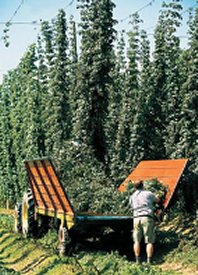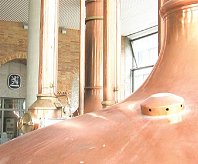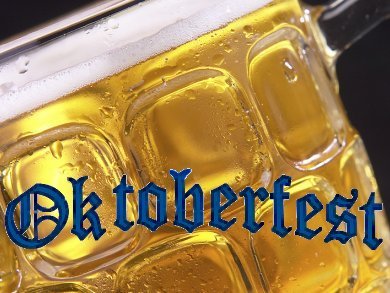As hops themselves actually are not bitter, and the wort tastes quite sweet, where does beer get its bitter taste from?
We will also see why the designation “Oktoberfest rearrangement” is in fact rather appropriate.
5) Hops
Hop plants flourish in moderate climates, although they are quite demanding with respect to the amount of daylight, summer temperature, rainfall, and groundwater. With principal growing regions being the Hallertau (Bavarian: “Halledau”), Middle Franconia, and the vicinity of Tettnang, Germany, is the leading producer of hops, responsible for approximately 30 % of world output.
The hop plant, Humulus lupulus, belongs to the Cannabaceae or hemp family. Its bines wind themselves clockwise around virtually anything within reach. In one year, stems (ca. 1 cm diameter) can reach a length of 6–8 meters (see Fig. 6), thus the hop plant is in the ranks of the world’s most rapidly growing plants.

Figure 6. Hops.
A given hop plant can be either male or female, but for brewing purposes only unfertilized female blossoms can be utilized; the blooming period is June through July. Male plants are rigorously eliminated from the fields.
At the base of the hop petals are glands that excrete a yellow-brown resin, lupulin. The peg-shaped flower clusters called umbels, which are harvested in August/September, consist of approximately 80 % water. They must be dried immediately, by using a forceful stream of warm air (30–50 °C) in special hops-drying kilns. Dried blossoms are then stored in a cool place until processing time.
It has become increasingly common in the brewing industry to utilize a hops extract obtained by treatment of pulverized flower clusters either with ethanol or supercritical carbon dioxide, both of which are regarded as “natural” constituents of beer.
Because the hops effectively determine the character of a beer, especially great care is devoted to the selection of the variety or varieties employed, as well as to the associated processing. A fundamental distinction is made between bitter and aromatic hops. In Germany, the predominant types of aromatic hops are Hersbrucker, Hallertauer, Tettnanger, and Perle, with the principal bitter hops types being Northern Brewer and Brewers Gold.
How is it that beer is bitter, even though hops themselves actually are not bitter, and the wort – as a consequence of its maltose content – tastes quite sweet?
Young hop sprouts from the various growing regions are, like asparagus, often collected in spring to be eaten and they are considered to be a real delicacy. What seems at first to be a major change in taste must, of course, be attributable somehow to chemistry; indeed, the formation of bitter substances that occurs during a brief (30–60 minute) boiling of the wort (see The Oktoberfest Rearrangement: Part 1, Section 4) actually amounts to a chemical high point of beer brewing.
What transpires chemically with hops in the traditional copper brewing kettle (see Fig. 7)?
First, volatile oils are released from the hops, conferring upon beer its “hoppy” aroma. The developing bitter taste comes indirectly from hop components known as α-acids, which can represent as much as 12 % of the dry weight of hop umbels.

Figure 7. A brewing kettle.
These so-called α-acids are a mixture of humulone (6), cohumulone (7), and adhumulone (8) (see Fig. 8) – names that come from a rather confusing traditional nomenclature. The α-acids are also sometimes known cumulatively simply as “humulones”. The structure of the principal component (at least with respect to hops), humulone itself, was determined by H. Wieland (Nobel Prize for Chemistry, 1927) [13,14].
6) The Oktoberfest Rearrangement
What occurs when the sparingly soluble, non-bitter α-acids are heated in water or in wort is formation of a corresponding set of water-soluble, distinctly bitter-tasting “iso-α-acids” (9–11) (see Fig. 8). This transformation, in which six-membered ring compounds become compounds with five-membered rings, is thus the source of the classic bitter flavor one always associates with beer.
.jpg)
Figure 8. The “Oktoberfest rearrangement”.
The terminology “α-” and “iso-α-” acids, employed generally in the brewing industry, emphasizes the acidic character of all the compounds (pK ca. 5.5), an acidity that is due to the considerable stability of a deprotonated form of their inherent β-triketo systems.
The three diverse R residues shown in Fig. 8 point to the biochemical origins of these natural products: the residue R = –CH2–CH(CH3)2 stems from the amino acid leucine, R = –CH(CH3)2 from valine, and R = –CH(CH3)–CH2–CH3 from isoleucine.
Perhaps it now becomes clearer why the designation “Oktoberfest rearrangement” for this unusual reaction is in fact rather appropriate.
7) The Oktoberfest Rearrangement in Detail
Formation of the characteristic bitter substances when wort is boiled will be illustrated here using the example humulone (6) itself (see Fig. 9) [10].
.gif)
Figure 9. The Oktoberfest rearrangement in detail.
The natural product humulone has the S configuration at C-6. As in the course of rearrangement this C-6 becomes the non-stereogenic carbon atom C-6* in the isohumulones (9a) and (9b), it would seem that complete racemization must occur. But this is not what one observes! Numerous research groups have been engaged in studying the overall reaction mechanism [15], and their work has established the following:
- The reaction occurs quantitatively in hot water, although addition of base causes the rate to increase. This means that the rate-determining step must involve an anionic species.
- The rearrangement leads to only two of the four theoretically possible isomeric isohumulones [16].
- Quite recently, it became possible to determine unambiguously the stereochemistry of these two diastereomers [17]. Both of the isohumulones, (9a) and (9b), have the S configuration at C-4; in cis-isohumulone, the C-5 center is R configured, but in trans-isohumulone it is S configured. The terminology cis and trans here refers to relative placements of the isoprenyl residue at C-5 and the hydroxy group at C-4.
The reaction mechanism can be viewed as a base-catalyzed α-ketol rearrangement, in which a substituent R2 of a tertiary alcohol undergoes an anionic 1,2-shift to the carbon atom of a neighboring keto group, as in:
R1CO–C(OH)R2R3 → R1R2C(OH)–COR3
After deprotonation of (6) to (12), the bond C-1–C-6 breaks open, whereupon C-1 retains the electrons and carries out a nucleophilic attack from below on the α-keto group (i.e., at C-5), from the opposite side to the OH group. Consequently, the S configuration at C-6 in humulone establishes the configuration at the newly created C-4 stereocenter in the rearranged anion (13). The anion (14), in tautomeric equilibrium with (13), is protonated at C-5 in the final step of the reaction. Attack of a proton can occur from either side, leading to a mixture of the diastereomeric isomers cis– and trans-isohumulone (9a) and (9b), respectively. Due to its greater thermodynamic stability, cis-isohumulone is formed preferentially (55:45), as in this way the two large isoprene residues at C-4 and C-5 end up in a trans relationship.
Unfortunately, the yield of bitter materials is low when whole hop umbels are used: only 30 % of the available α-acids are rearranged to iso-α-acids. Hops represents by far the most expensive raw material in beer brewing, so attempts have long been made to improve the yield, first by use of hops that had been ground and pressed into pellets. Now, the α-acids are often extracted with supercritical carbon dioxide, with this extract then being introduced into the wort, a procedure that reduces production costs and also permits more precise control over the bitterness of the beer.
The composition of a “hopped” and boiled wort largely determines the color, flavor, and aroma of the resulting beer. To characterize a wort, one generally relies on measuring the quantity of dissolved solids by distillative removal of water. This solids content, expressed in weight-percent, is known as the “original wort”, and is expected to fall between 4 and 20 %.
The German beer tax law defines five different categories of beer, as a function of the “original wort” value (“Stammwürzgehalt” or “SW”):
- Basic beer (SW < 7 %)
- Draught beer (SW 7–10.9 %)
- Pils (SW 11–15.9 %)
- Stout (SW > 16 %)
- Bock beer and double bock (SW > 18 %)
Much more than 90 % of the beer consumed in Germany is ale or lager, with an alcohol content in the vicinity of 5 vol-%. The favorite (61 %) is pils, followed by export varieties (12 %), and then wheat beer (8 %). This distribution varies considerably by region, however, i.e., Kölsch and alt beer are preferred in North Rhine-Westphalia, but pale ale (“Helles”) in Bavaria and Baden-Württemberg; Berliner Weiße, a draught wheat beer, is found almost exclusively in and around Berlin, where it is a favorite.
The higher the “SW” value, the stronger the flavor of the beer, and the higher both the beer tax and the alcohol content. The latter tends to be roughly one third of the SW value.
The market share in Germany of alcohol-free beer (alcohol content < 0.5 vol-%) is 2–3 % nationwide, although its popularity appears to be increasing (all the data above is from 2006).
8) Fermentation
After the wort has been cooled and filtered, roughly 3 grams of yeast is added per liter, causing alcoholic fermentation to commence. For the first 24 hours, this yeast subsists solely on the glucose present in the wort, generating alcohol in the process [3]. As the glucose concentration falls, the yeast starts synthesizing two new enzymes, maltosepermease and maltase. With the help of these enzymes, from day two of fermentation the sugar maltose (4) is transported into the interior of the yeast cells, where it is cleaved into two glucose molecules. These molecules are in turn degraded to alcohol.
Starting on the third day of fermentation, and with the aid of another newly synthesized enzyme, maltotriosepermease, the yeast accepts and begins to metabolize maltotriose (5). The latter is first cleaved into three glucose molecules, and ultimately processed to ethanol and carbon dioxide. The entire fermentation process takes approximately 6–7 days.
“Top fermenting” (“obergärige”) beers (Kölsch, alt, ale, wheat beer, and Berliner Weiße) are fermented at 15–20 °C, and at the end of fermentation the yeast rises and collects at the surface. By contrast, “bottom fermenting” (“untergärige”) beers (pilsner, pale ale, lager, and bock) are fermented at 5–9 °C, with the yeast in this case settling to the bottom. The differences between the two processes are a function not only of the fermentation temperature, but also of the type of yeast employed.
9) Maturation and Bottling
Once fermentation is complete, the new beer is regarded as “green” or “young”. At this stage it is not considered drinkable, so it must mature or “ripen” for three to four weeks at 0–2 °C. During this time, yeast residues break down undesirable aroma/flavor components like hydrogen sulfide, acetaldehyde, and above all penta-2,3-dione and diacetyl (i.e., butan-2,3-dione). Particularly in pilsener beer, diacetyl lends undesirable characteristics, the compound being considered permissible only at the ppb (10–9) level. This is actually somewhat surprising, as the same compound helps give butter its special “buttery” aroma. Apparently the smell associated with diacetyl is altered when this substance is combined with the other aroma-conferring components typical of beer.
References
[13] H. Wieland, Ber. Dtsch. Chem. Ges. 1925, 58, 2012. DOI: 10.1002/cber.19250580912
[14] J. F. Carson, J. Am. Chem. Soc. 1951, 73, 4652. DOI: 10.1021/ja01154a046
[15] D. De Keukeleire, Quim. Nova 2000, 23, 108. DOI: 10.1590/S0100-40422000000100019
[16] D. De Keukeleire, M. Verzele, Tetrahedron 1970, 26, 385. DOI: 10.1016/S0040-4020(01)97835-4
[17] J. Urban, Clinton J. Dahlberg, Brian J. Carroll, Werner Kaminsky, Angew. Chem. Int. Ed. 2013, 52, 1553.
DOI: 10.1002/anie.201208450
Prof. Klaus Roth
Freie Universität Berlin, Germany.
The article has been published in German in:
and was translated by W. E. Russey.
The Oktoberfest Rearrangement: Part 1
A closer look at the chemical role hops play in the beer-brewing process shows how beer owes its marvelous flavor to a great deal of chemistry.
The Oktoberfest Rearrangement: Part 3
The chemistry involved in the production of beer foam or “head” is explained.
See all articles by Klaus Roth published by ChemViews magazine
Closely Related
- Chemistry of a Hangover — Alcohol and its Consequences,
Kluas Roth,
ChemViews Magazine 2011.
DOI: 10.1002/chemv.201000074
How can a tiny molecule like ethanol be at the root of so much human misery? - From Sip to Slip: How our Bodies Process Alcohol,
ChemViews Magazine 2013, August.
DOI: 10.1002/chemv.201300091
What happens to alcohol after it has been consumed?


